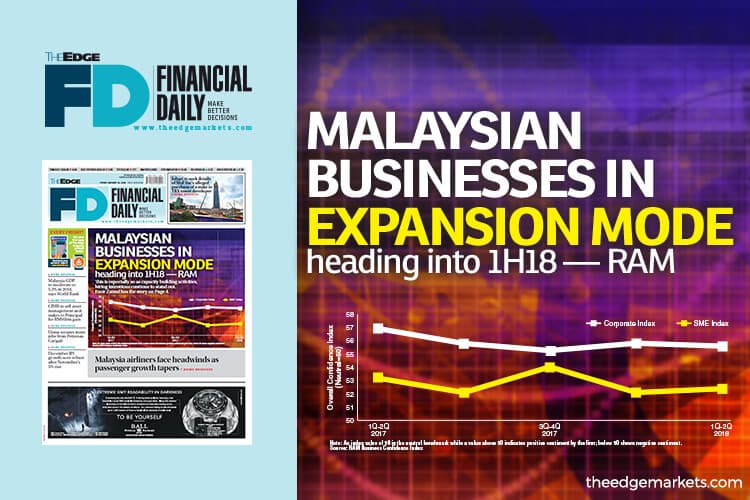
This article first appeared in The Edge Financial Daily on January 12, 2018
KUALA LUMPUR: Malaysian businesses are in a mode to invest to build capacity, with the intention to hire more, as the country moves into the first half of 2018 (1H18), according to a business confidence survey jointly conducted by RAM Holdings Bhd and RAM Credit Information Sdn Bhd.
The survey, named the Business Confidence Index (BCI), polled 3,474 companies — 974 large corporates and 2,500 small and medium enterprises (SMEs) — across five main industry segments, to assess their sentiment on seven key aspects of their business, namely turnover, profitability, business expansion, hiring, capital investment, capacity utilisation and access to bank financing.
“Based on the six-month outlook from the survey, the overall positive readings of the BCI across the corporates and SMEs suggest that Malaysia’s economic momentum remains on track. This is especially so as capacity building activities (business expansion and capital investment) and hiring intentions continue to stand out as the most positive aspects.
“This optimism, among Malaysian firms, corresponds with the overall positive view of global economic growth for 2018,” RAM Holdings group chief executive officer Datuk Seri Dr K Govindan told reporters during a briefing on the BCI findings yesterday.
The BCI results indicate that private investment activities would remain resilient heading into 2018, he said, with companies showing strong intentions to increase their headcount, though marginally lower compared with a year ago. And given the longer-term nature of these activities, they highlight the companies’ optimism towards Malaysia’s medium-term outlook, Govindan said.
“Such hiring intentions are the strongest among agriculture/mining and manufacturing firms, which are consistent with the output recovery for the palm oil sectors and also external demand for manufactured goods,” according to a summary of the report’s findings.
Findings from the BCI indicate consistent “positive” sentiment readings in both corporates and SME indices, of 55.6 and 52.4 respectively, as firms remain confident about their business performance prospects going into the first quarter (1Q) and 2Q of 2018.
An index value of 50 denotes the benchmark “neutral” level, while a value above 50 indicates “positive” sentiment, while a below 50 reading shows “negative” sentiment.
In comparison, the index was at 56.9 for corporates and 53.2 for SMEs for the first two quarters of 2017, which was consistent with the start of Malaysia’s economic recovery as gross domestic product (GDP) growth surged to 5.7% in 1H17.
Although now lower, the index still carries above-benchmark readings for 1Q to 2Q of 2018. “This also corresponds with RAM’s expectations of more moderate, albeit robust GDP growth anticipated this year at 5.2%, supported by the strengthening domestic demand and resilient external markets,” Govindan said.
Govindan noted that SMEs showed a slight downside in business prospects, compared to their corporate counterparts, as SMEs expressed higher variations in their turnover and profitability expectations.
SMEs have also been observed to face larger issues with revenue collection punctuality and visibility on future contract awards. Constrained by limited resources and the lack of scale, this also explains the lower optimism among SMEs, RAM Holdings’ report noted.
“This indicates the need for continued close engagement with SMEs to help these firms gain better access to funding and to raise their participation in international trade,” Govindan said.
For SMEs, Govindan noted that business expansion often entails diversification into new businesses, moving upstream or downstream, or even relocation to improve prospects. That, he said, explains why SMEs remain optimistic in spite of short-term adverse business performance.
Meanwhile, RAM expects the ringgit to average around 4.10 to 4.20 against the US dollar for 2018, compared with an average of 4.35 in 2017, signifying an appreciation of the ringgit of about 4% to 5%.
“The recent strengthening of the ringgit is driven in part by the bullishness in oil prices, as well as some weakening in the US dollar. So there is a lot of feel good factor[s] for the ringgit at the moment. However, we don’t expect it to stay as lofty or as strong as it is now for the whole year,” said RAM economist Kristina Fong.